northwestern N.M.
NPS Website; Local Website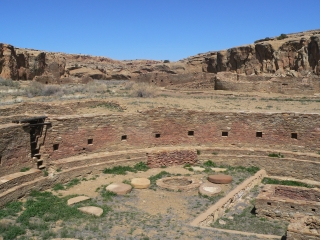
The place believed to be the center of the Ancestral Puebloan world for nearly 400 years, from the 9th through the 13th centuries. The Park, a UNESCO World Heritage Site, consists of numerous freestanding ruins displaying architectural mastery and brilliant engineering.
BEAUTY (9/10)
Modestly sized mesas surround the Chaco Canyon area but are not tall enough to dominate the landscape. The dusty scrub filled high desert takes precedence in the area as far as the eye can see. The beauty instead comes from the many D-shaped stone Chaco complexes. The intricate masonry is separated into five easily distinguishable styles that evolved throughout time. The buildings intertwine with the curves and indentations of the mesas to a sublime degree. The sheer size and scale of the Chaco buildings is awe-inspiring.
HISTORICAL INTEREST (10/10)
Even without documented histories and surefire conclusions, once you see the ruins it is easy to accept that Chaco was the focal point of a world. We will never know how big that world was. It definitely stretched throughout northwestern New Mexico. Elaborately planned prehistoric road systems sprout from this Site, as if it were the hub of a wheel. Did this trade system spread throughout North America, to the Mississippian culture to the east and to the Aztecs in central Mexico? Archeological evidence suggests so.
The ruins of Pueblo Bonito and Chetro Ketl are both momentous and situated just yards apart. To any visitor, these grand structures just feel important. The buildings are marked throughout with astronomical markers. Easy to understand when you see the blanket of stars in the big sky overhead. A people thrived here for over 300 years, Chaco Culture NHP is one of the world’s historic treasures.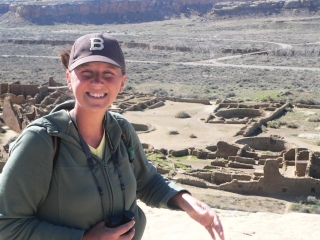
License plates from Alaska, New Hampshire, Maine and Vermont told us we were not the only ones far from home. Nor were we, it seems, the only people on extended road trips. Custom vans, station wagons and other vehicles were strapped with kayaks, bikes, and Yakima gear boxes and wore the dirt of heavy use. These were not your average day trippers.
The roads to Chaco Culture NHP are kept unpaved on purpose; it is not a place you will end up without trying. You have to want to come here. The end result is a set of visitors that are more informed, more interested and a little more hardcore than those we have met at other sites.
EASE OF USE/ACCESS (1/5)
We were worried about getting to Chaco Culture NHP. We even debated skipping the Site altogether. Why? Well, the Site is in remote northwestern New Mexico, its entrance 21 miles from U.S. 550 down an unpaved dirt road. We should not have been so scared.
The road, while not perfect, is more than manageable. Still, we were lucky that it had not rained in the recent past. The unpaved road serves as an effective barrier to the tourist trade. Chaco Culture NHP is one of only three pre-Columbian World Heritage Cultural Sites in the United States; if the road were paved, it would be difficult to protect the ancient ruins.
Once inside the Park, the road magically becomes paved and all compact car owners breathe a collective sign of relief. A nine-mile one-way loop road follows Chaco Canyon. Short hikes to five separate grand ruin complexes begin from the road’s five parking pullouts. Once inside, it is relatively easy to see most of Chaco’s famous landmarks.
We approached the site from the northeast, from U.S. 550 and down Indian road 7950. Some maps (Mapquest, yes; NPS brochure, yes; Rand McNally, no) show an approach from the southwest. New Mexico Route 57, a 20-mile difficult dirt road, accesses the park via Indian Route 9 (also unpaved we think) where it meets N.M. Route 371 at Crownpoint. A Ranger at the Northwest New Mexico VC in Grants, N.M. told us that those roads are rough and not to attempt it without a 4x4.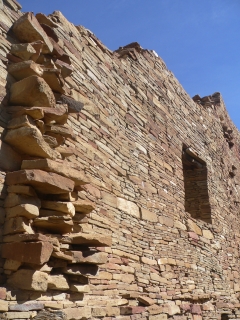
The bookstore has a terrific array of Navajo, Ancestral Puebloan, local history and astronomy books. We liked the terra-cotta raised relief representation of Pueblo Bonito’s architectural plan but had neither the $52.95 to purchase it nor a place in the Altima to ensure its safe passage back to Harrisburg.
The bookstore does not sell anything vital to sustaining life, like food, drink and gasoline. It does provide pumped water if you are really in a fix. Make sure you have a full tank of gas, dinner, snacks and firewood. You won’t be able to get anything here.
COSTS (3/5)
Entry is $8 per vehicle, free with the National Parks Pass. 49 campsites are available at $10 per site. The campground did not fill during our stay, but it was close to capacity. Get to the Park as early as you can. Visiting a fair share of the ruins will take at least one loooooong day, probably two. The only place to stay is at the campground; there are no motels within a 50 miles radius.
RANGER/GUIDE TO TOURIST RATIO (1/5)
Chaco Culture NHP relies heavily on their annual shipment of Student Conservation Association recruits. Newly arrived, fresh faced volunteers led the daily tours, manned the bookstore and did just about everything one would expect a Ranger to do. Except for knowledgably answer questions.
TOURS/CLASSES (7/10)
In place of Ranger tours, both the bookstore and the trailheads offer self-guided booklets for six different trail systems: Chetro Ketl, Casa Rinconada, Pueblo Bonito, Pueblo del Arroyo, Petroglyph and the Backcountry. All are $0.50 except Petroglyph $0.75 and the Backcountry $2.00. We bought most of these terrific guides and Gab became a fill-in Ranger. The booklets delve into their topics and are the cornerstone to the park’s educational experience.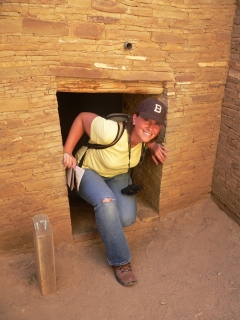
The museum is cramped, but nice. Its walls are constructed with a mock version of Chaco’s five architectural styles. The museum also displays a diverse collection of pottery unearthed on site. The Museum adds little to your stay that cannot be achieved at the ruins themselves.
The Park owns a battalion of high-powered telescopes and holds astronomy programs every Tuesday, Friday and Saturday. We picked the wrong day to arrive, Wednesday. We would have tailored our visit around a night sky program had we known about them in advance.
FUN (8/10)
Chaco Culture NHP is so far from modern life that a visit becomes a walk back in time. Concentration, relaxation and quiet speculation are easy achievements. It is difficult to comprehend the scope of ancient American civilizations through their ruins, especially when those ruins are a short driving distance from a Taco Bell or a Best Western. The dirt road in removes nearly all outside influence, Chaco Canyon has been left in peace. Understanding and remembrance is easier. This is a profound place.
You can explore in and around most of ancient ruins, a rarity in National Parks. Four moderately easy backcountry trails lead to even less visited ruins. The Peñasco Blanco Trail leads down the Chaco Canyon, past petroglyphs, pictographs and other prehistoric canyon interactions. The South Mesa and Pueblo Alto trails both lead up to mesa tops and give the hiker a bird’s eye view, blue print type imagery, of the Chaco building complexes.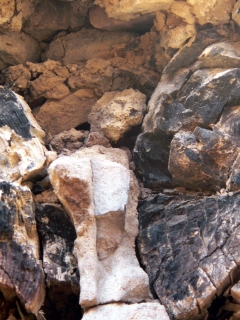
What makes Chaco’s history so much more compelling than the other Ancestral Puebloan ruins scattered throughout the southwest?
We were awed by the grandeur and architecture of the great houses and ancestral roads. These are the most impressive pre-Columbian ruins and buildings in the National Park Service.
But is the drive worth it?
A resounding yes. The trip feels more like a pilgrimage than a visit. You have repeated the routes of centuries of travelers into Chaco Canyon. The buildings possess a magnetic pull; they are still full of life. It is ironic that this incredibly remote place accessible only by dirt road was once the center of a people’s world and the hub of a complex highway and trade system. What will New York, Los Angeles and Chicago look like in 800 years? You never know.
TOTAL 60/80
www.usa-c2c.com
© 2005